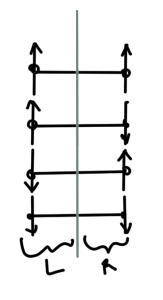[Click here for a PDF of this post with nicer formatting]
Q: [1] pr 4.7
- (a)
Find the time reversed form of a spinless plane wave state in three dimensions. - (b)
For the eigenspinor of \( \Bsigma \cdot \ncap \) expressed in terms of polar and azimuthal angles \( \beta\) and \( \gamma \), show that \( -i \sigma_y \chi^\conj(\ncap) \) has the reversed spin direction.
A: part (a)
The Hamiltonian for a plane wave is
\begin{equation}\label{eqn:timeReversalPlaneWaveAndSpinor:20}
H = \frac{\Bp^2}{2m} = i \PD{t}.
\end{equation}
Under time reversal the momentum side transforms as
\begin{equation}\label{eqn:timeReversalPlaneWaveAndSpinor:40}
\begin{aligned}
\Theta \frac{\Bp^2}{2m} \Theta^{-1}
&=
\frac{\lr{ \Theta \Bp \Theta^{-1}} \cdot \lr{ \Theta \Bp \Theta^{-1}} }{2m} \\
&=
\frac{(-\Bp) \cdot (-\Bp)}{2m} \\
&=
\frac{\Bp^2}{2m}.
\end{aligned}
\end{equation}
The time derivative side of the equation is also time reversal invariant
\begin{equation}\label{eqn:timeReversalPlaneWaveAndSpinor:60}
\begin{aligned}
\Theta i \PD{t}{} \Theta^{-1}
&=
\Theta i \Theta^{-1} \Theta \PD{t}{} \Theta^{-1} \\
&=
-i \PD{(-t)}{} \\
&=
i \PD{t}{}.
\end{aligned}
\end{equation}
Solutions to this equation are linear combinations of
\begin{equation}\label{eqn:timeReversalPlaneWaveAndSpinor:80}
\psi(\Bx, t) = e^{i \Bk \cdot \Bx – i E t/\Hbar},
\end{equation}
where \( \Hbar^2 \Bk^2/2m = E \), the energy of the particle. Under time reversal we have
\begin{equation}\label{eqn:timeReversalPlaneWaveAndSpinor:100}
\begin{aligned}
\psi(\Bx, t)
\rightarrow e^{-i \Bk \cdot \Bx + i E (-t)/\Hbar}
&= \lr{ e^{i \Bk \cdot \Bx – i E (-t)/\Hbar} }^\conj \\
&=
\psi^\conj(\Bx, -t)
\end{aligned}
\end{equation}
A: part (b)
The text uses a requirement for time reversal of spin states to show that the Pauli matrix form of the time reversal operator is
\begin{equation}\label{eqn:timeReversalPlaneWaveAndSpinor:120}
\Theta = -i \sigma_y K,
\end{equation}
where \( K \) is a complex conjugating operator. The form of the spin up state used in that demonstration was
\begin{equation}\label{eqn:timeReversalPlaneWaveAndSpinor:140}
\begin{aligned}
\ket{\ncap ; +}
&= e^{-i S_z \beta/\Hbar} e^{-i S_y \gamma/\Hbar} \ket{+} \\
&= e^{-i \sigma_z \beta/2} e^{-i \sigma_y \gamma/2} \ket{+} \\
&= \lr{ \cos(\beta/2) – i \sigma_z \sin(\beta/2) }
\lr{ \cos(\gamma/2) – i \sigma_y \sin(\gamma/2) } \ket{+} \\
&= \lr{ \cos(\beta/2) – i \begin{bmatrix} 1 & 0 \\ 0 & -1 \\ \end{bmatrix} \sin(\beta/2) }
\lr{ \cos(\gamma/2) – i \begin{bmatrix} 0 & -i \\ i & 0 \\ \end{bmatrix} \sin(\gamma/2) } \ket{+} \\
&=
\begin{bmatrix}
e^{-i\beta/2} & 0 \\
0 & e^{i \beta/2}
\end{bmatrix}
\begin{bmatrix}
\cos(\gamma/2) & -\sin(\gamma/2) \\
\sin(\gamma/2) & \cos(\gamma/2)
\end{bmatrix}
\begin{bmatrix}
1 \\
0
\end{bmatrix} \\
&=
\begin{bmatrix}
e^{-i\beta/2} & 0 \\
0 & e^{i \beta/2}
\end{bmatrix}
\begin{bmatrix}
\cos(\gamma/2) \\
\sin(\gamma/2) \\
\end{bmatrix} \\
&=
\begin{bmatrix}
\cos(\gamma/2)
e^{-i\beta/2}
\\
\sin(\gamma/2)
e^{i \beta/2}
\end{bmatrix}.
\end{aligned}
\end{equation}
The state orthogonal to this one is claimed to be
\begin{equation}\label{eqn:timeReversalPlaneWaveAndSpinor:180}
\begin{aligned}
\ket{\ncap ; -}
&= e^{-i S_z \beta/\Hbar} e^{-i S_y (\gamma + \pi)/\Hbar} \ket{+} \\
&= e^{-i \sigma_z \beta/2} e^{-i \sigma_y (\gamma + \pi)/2} \ket{+}.
\end{aligned}
\end{equation}
We have
\begin{equation}\label{eqn:timeReversalPlaneWaveAndSpinor:200}
\begin{aligned}
\cos((\gamma + \pi)/2)
&=
\textrm{Re} e^{i(\gamma + \pi)/2} \\
&=
\textrm{Re} i e^{i\gamma/2} \\
&=
-\sin(\gamma/2),
\end{aligned}
\end{equation}
and
\begin{equation}\label{eqn:timeReversalPlaneWaveAndSpinor:220}
\begin{aligned}
\sin((\gamma + \pi)/2)
&=
\textrm{Im} e^{i(\gamma + \pi)/2} \\
&=
\textrm{Im} i e^{i\gamma/2} \\
&=
\cos(\gamma/2),
\end{aligned}
\end{equation}
so we should have
\begin{equation}\label{eqn:timeReversalPlaneWaveAndSpinor:240}
\ket{\ncap ; -}
=
\begin{bmatrix}
-\sin(\gamma/2)
e^{-i\beta/2}
\\
\cos(\gamma/2)
e^{i \beta/2}
\end{bmatrix}.
\end{equation}
This looks right, but we can sanity check orthogonality
\begin{equation}\label{eqn:timeReversalPlaneWaveAndSpinor:260}
\begin{aligned}
\braket{\ncap ; -}{\ncap ; +}
&=
\begin{bmatrix}
-\sin(\gamma/2)
e^{i\beta/2}
&
\cos(\gamma/2)
e^{-i \beta/2}
\end{bmatrix}
\begin{bmatrix}
\cos(\gamma/2)
e^{-i\beta/2}
\\
\sin(\gamma/2)
e^{i \beta/2}
\end{bmatrix} \\
&=
0,
\end{aligned}
\end{equation}
as expected.
The task at hand appears to be the operation on the column representation of \( \ket{\ncap; +} \) using the Pauli representation of the time reversal operator. That is
\begin{equation}\label{eqn:timeReversalPlaneWaveAndSpinor:160}
\begin{aligned}
\Theta \ket{\ncap ; +}
&=
-i \sigma_y K
\begin{bmatrix}
e^{-i\beta/2} \cos(\gamma/2) \\
e^{i \beta/2} \sin(\gamma/2)
\end{bmatrix} \\
&=
-i \begin{bmatrix} 0 & -i \\ i & 0 \\ \end{bmatrix}
\begin{bmatrix}
e^{i\beta/2} \cos(\gamma/2) \\
e^{-i \beta/2} \sin(\gamma/2)
\end{bmatrix} \\
&=
\begin{bmatrix}
0 & -1 \\
1 & 0
\end{bmatrix}
\begin{bmatrix}
e^{i\beta/2} \cos(\gamma/2) \\
e^{-i \beta/2} \sin(\gamma/2)
\end{bmatrix} \\
&=
\begin{bmatrix}
-e^{-i \beta/2} \sin(\gamma/2) \\
e^{i\beta/2} \cos(\gamma/2) \\
\end{bmatrix} \\
&= \ket{\ncap ; -},
\end{aligned}
\end{equation}
which is the result to be demononstrated.
References
[1] Jun John Sakurai and Jim J Napolitano. Modern quantum mechanics. Pearson Higher Ed, 2014.




